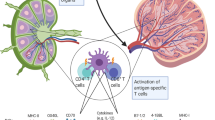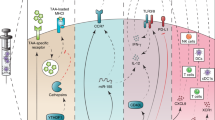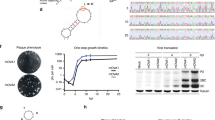Abstract
Immunization with dendritic cells (DCs) transfected with genes encoding tumor-associated antigens (TAAs) is a highly promising approach to cancer immunotherapy. We have developed a system, using complexes of plasmid DNA expression constructs with the cationic peptide CL22, that transfects human monocyte-derived DCs much more efficiently than alternative nonviral agents. After CL22 transfection, DCs expressing antigens stimulated autologous T cells in vitro and elicited primary immune responses in syngeneic mice, in an antigen-specific manner. Injection of CL22-transfected DCs expressing a TAA, but not DCs pulsed with a TAA-derived peptide, protected mice from lethal challenge with tumor cells in an aggressive model of melanoma. The CL22 system is a fast and efficient alternative to viral vectors for engineering DCs for use in immunotherapy and research.
This is a preview of subscription content, access via your institution
Access options
Subscribe to this journal
Receive 12 print issues and online access
$209.00 per year
only $17.42 per issue
Buy this article
- Purchase on Springer Link
- Instant access to full article PDF
Prices may be subject to local taxes which are calculated during checkout






Similar content being viewed by others
References
Romani, N. et al. Proliferating dendritic cell progenitors in human blood. J. Exp. Med. 180, 83–93 ( 1994).
Nestle, F.O. et al. Vaccination of melanoma patients with peptide- or tumour lysate-pulsed dendritic cells. Nat. Med. 4, 328– 332 (1998).
Hsu, F.J. et al. Vaccination of patients with B-cell lymphoma using autologous antigen-pulsed dendritic cells. Nat. Med. 2, 52– 58 (1996).
Thurner, B. et al. Vaccination with MAGE-3A1 peptide-pulsed mature, monocyte-derived dendritic cells expands specific cytotoxic T cells and induces regression of some metastases in advanced stage IV melanoma. J. Exp. Med 190, 1669–1678 (1999).
Nair, S.K. et al. Induction of primary carcinoembryonic antigen (CEA)-specific cytotoxic T lymphocytes in vitro using human dendritic cells transfected with RNA. Nat. Biotechnol. 16, 364–369 (1998).
Zhang, W. et al. Enhanced therapeutic efficacy of tumour RNA-pulsed dendritic cells after genetic modification with lymphotactin. Hum. Gene Ther. 10, 1151–1161 (1999).
Ludewig, B. et al. Immunotherapy with dendritic cells directed against tumour antigens shared with normal host cells results in severe autoimmune disease. J. Exp. Med. 191, 795–803 ( 2000).
Kaplan, J.M. et al. Induction of antitumour immunity with dendritic cells transduced with adenovirus vector-encoding endogenous tumour-associated antigens. J. Immunol. 163, 699–707 (1999).
Hung, K. et al. The central role of CD4+ T cells in the antitumour immune response . J. Exp. Med. 188, 2357– 2368 (1998).
De Veerman, M. et al. Retrovirally transduced bone marrow-derived dendritic cells require CD4+ T cell help to elicit protective and therapeutic antitumour immunity. J. Immunol. 162, 144– 151 (1999).
Kalams, S.A. & Walker, B.D. The critical need for CD4 T cell help in maintaining effective cytotoxic T lymphocyte responses . J. Exp. Med. 188, 2199– 2204 (1998).
Schnell, S., Young, J.W., Houghton, A.N. & Sadelain, M. Retrovirally transduced dendritic cells require CD4+ T cell help to elicit antitumour immunity: implications for clinical use of dendritic cells. J. Immunol. 164, 1243– 1250 (2000).
Arthur, J.F. et al. A comparison of gene transfer methods in human dendritic cells. Cancer Gene Ther. 4, 17–25 (1997).
Philip, R. et al. Transgene expression in dendritic cells to induce antigen-specific cytotoxic T cells in healthy donors. Cancer Gene Ther. 5, 236–246 (1998).
DiBrino M., Tsuchida, T., Turner, R.V., Coligan, J.E. & Biddison, W.E. HLA-A1 and HLA-A3 T cell epitopes derived from influenza virus proteins predicted from peptide binding motifs. J. Immunol. 151, 5930– 5935 (1993).
Lalvani. A. et al. Rapid effector function in CD8+ memory T cells. J. Exp. Med. 186, 859–865 (1997).
Taylor, P.M., Davey, J., Howland, K., Rothbard, J.B. & Askonas, B.A. Class I MHC molecules rather than other mouse genes dictate influenza epitope recognition by cytotoxic T cells. Immunogenetics 26, 267–272 (1987).
Bouchard, B., Del Marmol, V., Jackson, I.J., Cherif, D. & Dubertret, L. Molecular characterisation of a human tyrosinase-related protein-2 cDNA. Patterns of expression in melanocytic cells. Eur. J. Biochem. 219, 127– 134 (1994).
Okamoto, T. et al. Anti-tyrosinase-related protein-2 immune responses in vitiligo patients and melanoma patients receiving active specific immunotherapy. J. Invest. Dermatol. 111, 1034–1039 (1998).
Bloom, M.B. et al. Identification of tyrosinase-related protein 2 as a tumour rejection antigen for the B16 melanoma. J. Exp. Med. 185, 453–459 (1997).
Yang. Y., Li, Q., Ertl, H.C. & Wilson, J.M. Cellular and humoral immune responses to viral antigens create barriers to lung-directed gene therapy with recombinant adenoviruses. J. Virol. 69, 2004–2015 (1995).
Jonuleit, H. et al. Efficient transduction of mature CD83+ dendritic cells using recombinant adenovirus suppressed T cell stimulatory capacity. Gene Ther. 7, 249–254 ( 2000).
Knight, S.C., Iqball, S., Roberts, M.S., Macatonia, S. & Bedford, P.A. Transfer of antigen between dendritic cells in the stimulation of primary T cell proliferation . Eur. J. Immunol. 28, 1636– 1644 (1998).
Tüting, T. et al. Dendritic cell-based genetic immunisation in mice with a recombinant adenovirus encoding murine TRP2 induces effective anti-melanoma immunity. J. Gene Med. 1, 400–406 (1999).
Overwijk, W.W. et al. Vaccination with a recombinant vaccinia virus encoding a “self” antigen induces autoimmune vitiligo and tumour cell destruction in mice: requirement for CD4+ T lymphocytes. Proc. Natl. Acad. Sci. USA 96, 2982–2987 ( 1999).
Williams, S.G. et al. Repressor titration: a novel system for selection and stable maintenance of recombinant plasmids. Nucleic Acids Res. 26, 2120–2124 (1998).
Tüting, T., DeLeo, A.B., Lotze, M.T. & Storkus, W.J. Genetically modified bone marrow-derived dendritic cells expressing tumour-associated viral or “self” antigens induce antitumour immunity in vivo. Eur. J. Immunol. 27, 2702–2707 (1997).
Felgner P.L. et al. Nomenclature for synthetic gene delivery systems. Hum. Gene Ther. 8, 511–512 ( 1997).
Morgan, S.M., Wilkinson, G.W., Floettmann, E., Blake, N. & Rickinson, A.B. A recombinant adenovirus expressing an Epstein–Barr virus (EBV) target antigen can selectively reactivate rare components of EBV cytotoxic T-lymphocyte memory in vitro. J. Virol. 70, 2394–2402 (1996).
Corico, R. et al. (eds.) Current Protocols in Immunology. (Wiley, New York, NY; 2000).
Acknowledgements
We thank the Quality Control Department, Cobra Therapeutics, for endotoxin testing of plasmid DNA samples, the Manchester Blood Transfusion Service for supplying buffy coats, blood donors at Cobra Therapeutics and the Institute of Cancer Studies, Birmingham University, Yalem Bekele for phlebotomy and plasmid DNA preparation, Dr. T. Hanke for the influenza nucleoprotein gene, and the Bioconjugate Chemistry Department at Cobra Therapeutics for peptide synthesis.
Author information
Authors and Affiliations
Corresponding author
Rights and permissions
About this article
Cite this article
Irvine, A., Trinder, P., Laughton, D. et al. Efficient nonviral transfection of dendritic cells and their use for in vivo immunization. Nat Biotechnol 18, 1273–1278 (2000). https://doi.org/10.1038/82383
Received:
Accepted:
Issue Date:
DOI: https://doi.org/10.1038/82383
This article is cited by
-
Genetic Immunization With In Vivo Dendritic Cell-targeting Liposomal DNA Vaccine Carrier Induces Long-lasting Antitumor Immune Response
Molecular Therapy (2016)
-
Phase I/II trial of a dendritic cell vaccine transfected with DNA encoding melan A and gp100 for patients with metastatic melanoma
Gene Therapy (2011)
-
Immunisation with ‘naïve’ syngeneic dendritic cells protects mice from tumour challenge
British Journal of Cancer (2008)
-
Vaccines to prevent chronic hepatitis C virus infection: current experimental and preclinical developments
Journal of Gastroenterology (2007)
-
Combinational adenovirus-mediated gene therapy and dendritic cell vaccine in combating well-established tumors
Cell Research (2006)



